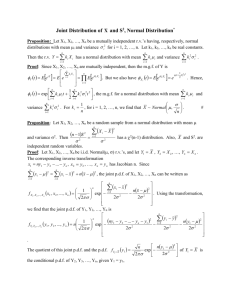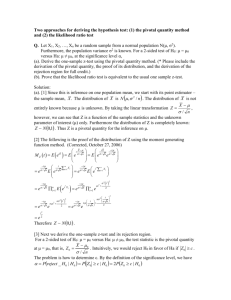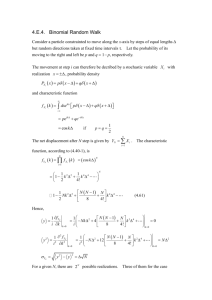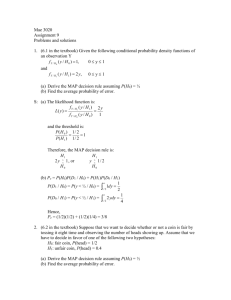Solution to Assignment 7
advertisement
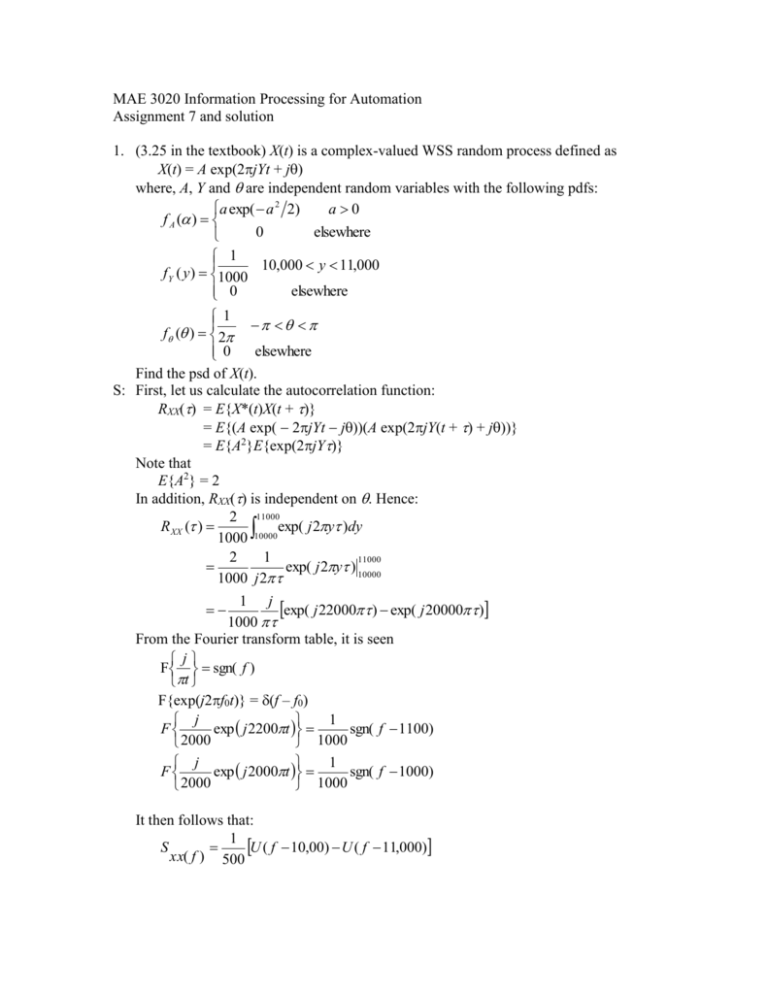
MAE 3020 Information Processing for Automation
Assignment 7 and solution
1. (3.25 in the textbook) X(t) is a complex-valued WSS random process defined as
X(t) = A exp(2jYt + j)
where, A, Y and are independent random variables with the following pdfs:
a exp( a 2 2)
a0
f A ( )
0
elsewhere
1
10,000 y 11,000
f Y ( y ) 1000
0
elsewhere
1
f ( ) 2
0
elsewhere
Find the psd of X(t).
S: First, let us calculate the autocorrelation function:
RXX() = E{X*(t)X(t + )}
= E{(A exp( 2jYt j))(A exp(2jY(t + ) + j))}
= E{A2}E{exp(2jY}
Note that
E{A2} = 2
In addition, RXX() is independent on . Hence:
2 11000
R XX ( )
exp( j 2y )dy
1000 10000
2
1
11000
exp( j 2y ) 10000
1000 j 2
1 j
exp( j 22000 ) exp( j 20000 )
1000
From the Fourier transform table, it is seen
j
F sgn( f )
t
F{exp(j2f0t)} = (f – f0)
1
j
F
exp j 2200t
sgn( f 1100)
2000
1000
1
j
F
exp j 2000t
sgn( f 1000)
2000
1000
It then follows that:
1
U ( f 10,00) U ( f 11,000)
S
xx( f ) 500
2. (3.35 in the textbook) Let Z(t) = x(t) + Y(t) where x(t) is a deterministic, periodic
power signal with a period T and Y(t) is a zero mean ergodic random process. Find
the autocorrelation function and also the psd function of Z(t) using time averages.
S: Z(t) = x(t) + Y(t)
1 T /2
RZZ ( ) T x(t ) x(t ) x(t ) y (t ) x(t ) y (t ) x(t ) y (t )dt
T T / 2
1 T /2
x(t ) x(t )dt RYY ( )
T T / 2
Note that the cross terms are dropped because x(t) is periodic (not because Y(t) has a
zero mean). Since x(t) is periodic, it can be written as follows:
2kt
2kt
x(t ) ak cos
bk sin
T
T
k
Hence,
2kt
2kt
2k (t )
2k (t )
x(t ) x(t ) a j cos
b j sin
a k cos
bk sin
T
T
T
T
l
k
Because of the orthogonality, it can be shown that:
1 t
2k
x(t ) x(t )dt ak2 bk2 cos
T
/
2
T
T
k
Therefore:
2k
RZZ ( ) ak2 bk2 cos
RYY ( )
T
k
Using the Fourier transform table:
ak2 bk2
k
k
S ZZ ( f )
f f RYY ( f )
2
T
T
k
3. (3.39 in the textbook) A stationary zero-mean Gaussian random process X(t) has an
autocorrelation function:
RXX() = 10 exp( )
Show that X(t) is ergodic in the mean and autocorrelation function.
S: (i) The mean
T /2
1
E X T E X (t )dt X 0
T / 2
T
1 T /2
var x(t ) 1 C XX ( )d
T T / 2 T
2 T
1 10 exp( )d
10 0 T
2 2
10 2 1 exp( T )
T T
since:
lim var[ x(t )] 0
T
X(t) is ergodic in the mean
(ii) The autocorrelation function
1 T /2
E R XX ( ) T E{ X (t ) X (t )dt
T T / 2
1 T /2
R XX ( )d
T T / 2
R XX ( )
R XX ( )d 10 exp( )d
0
0
10e d 10e d
10 10 20
Therefore, it is ergodic in the autocorrelation function.
4. (3.46 in the textbook) The probability density function of a random variable X is
shown in the figure below. (a) If X is quantized into four levels using a uniform
quantizing rule, find the MSE (Mean Square Error); (b) If X is quantized into four
levels using a minimum (MSE) non-uniform quantizer, find the quantizer end points
and output levels as well as the MSE.
fX(x)
1/2
-2
0
2
x
S: This problem deals with the quantilization. From the figure, it is seen that the
probability density function is:
1
f X ( x) 2 x ,
x 2
4
(a) Using a four-level uniform quantizer, we have:
-2 < x < -1: m = (-2 - 1) / 2 = -1.5
-1 < x < 0:
m = (-1 - 0) / 2 = -0.5
0 < x < 1:
m = (0 + 1) / 2 = 0.5
-2 < x < -1: m = (2 + 1) / 2 = 1.5
Hence:
N q E{( X m) 2 }
4
xi
i 1
xi 1
( x mi ) 2 f X ( x)dx
0
1
2
1 1
( x 1.5) 2 (2 x)dx ( x 0.5) 2 (2 x)dx ( x 0.5) 2 (2 x)dx ( x 1.5)( 2 x)dx
1
0
1
2 2
1 / 12
S q E m
2
4
mi
2
i 1
xi
xi 1
f X ( x)dx
3/ 4
Therefore, the mean squares error (MSE) is:
N q 1 / 12
1/ 9
Sq
3/ 4
(b) When nonuniform quantizer is used, the quantizer values, mi, cannot be
analytically determined. However, assuming that X is normally distributed (the
triangle is similar to normal after all),
Nq = (2.2)Q-1.96, when (Q >> 1)
Since Q = 4 (not much greater than 1), Nq = 0.1453. Thus,
N q 0.1453
0.1938
Sq
3/ 4
5. (4.6 in the textbook) The input-output relationship of a discrete-time linear timeinvariant causal system is given by:
Y(n) = h(0)X(n) + h(1)X(n-1) + … + h(k)X(n-k)
The input sequence X(n) is stationary, zero mean, Gaussian with
1 j 0
E{ X (n) X (n j )}
0 j 0
(a) Find the pdf of Y(n)
(b) Find RYY(n) and SYY(f).
S: (a) Since X(n) are Gaussian, Y(n) will be Gaussian. Its mean is:
E{Y(n)} = E{h(0)X(n) + h(1)X(n-1) + … + h(k)X(n-k)}
= h(0)E{X(n)} + h(1)E{X(n-1)} + … + h(k)E{X(n-k)}
=0
and its variance is:
E{Y2(n) } = E{[h2(0)X2(n) + h2(1)X2(n-1) +… + h2(k)X2(n-k)]}
= h2(0) + h2(1) +… + h2(k)
(c) The autocorrelation is:
R yy (n) R XX (n) * h(n) * h(n)
h( n) * h( n)
h( n j ) h( j )
j
h( n j ) h( j )
j
Hence:
J
h( n j ) h( j ) n J
RYY (n)
j o
0
nJ
In addition:
SYY ( f ) F RYY ( )
K
K
h(n )h( ) exp( j 2nf )
n K 0



